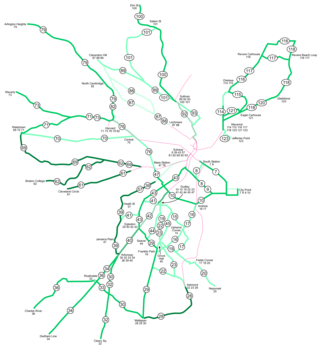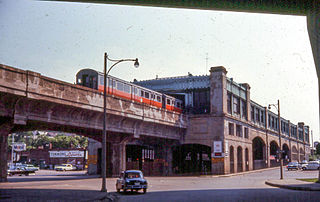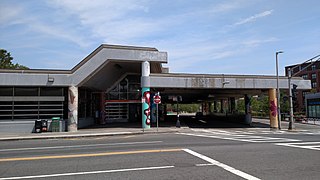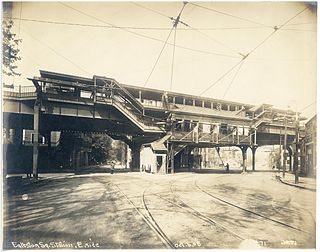
The Orange Line is a rapid transit line operated by the Massachusetts Bay Transportation Authority (MBTA) as part of the MBTA subway system. The line runs south on the surface from Oak Grove station in Malden, Massachusetts through Malden and Medford, paralleling the Haverhill Line, then crosses the Mystic River on a bridge into Somerville, then into Charlestown. It passes under the Charles River and runs through Downtown Boston in the Washington Street Tunnel. The line returns to the surface in the South End, then follows the Southwest Corridor southwest in a cut through Roxbury and Jamaica Plain to Forest Hills station.
The Southwest Corridor or Southwest Expressway was a project designed to bring an eight-lane highway into the City of Boston from a direction southwesterly of downtown. It was supposed to connect with Interstate 95 (I-95) at Route 128. As originally designed, it would have followed the right of way of the former Penn Central/New Haven Railroad mainline running from Readville, north through Roslindale, Forest Hills and Jamaica Plain, where it would have met the also-cancelled I-695. The 50-foot-wide median for the uncompleted "Southwest Expressway" would have carried the southwest stretch of the MBTA Orange Line within it, replacing the Washington Street Elevated railway's 1901/1909-built elevated railbed. Another highway, the four-lane South End Bypass, was proposed to run along the railroad corridor between I-695 in Roxbury and I-90 near Back Bay.

Forest Hills station is an intermodal transfer station in Boston, Massachusetts. It serves the MBTA rapid transit Orange Line and three MBTA Commuter Rail lines and is a major terminus for MBTA bus routes. It is located in Forest Hills, in the southern part of the Jamaica Plain neighborhood. Most Providence/Stoughton Line and Franklin/Foxboro Line trains, and all Amtrak Northeast Corridor trains, pass through the station without stopping. Forest Hills station is fully accessible on all modes.

Ruggles station is an intermodal transfer station in Boston, Massachusetts. It serves Massachusetts Bay Transportation Authority (MBTA) rapid transit, bus, and commuter rail services and is located at the intersection of Ruggles and Tremont streets, where the Roxbury, Fenway–Kenmore, and Mission Hill neighborhoods meet. It is surrounded by the campus of Northeastern University. Ruggles is a station stop for the Orange Line subway, as well as the Providence/Stoughton Line, Franklin/Foxboro Line, and Needham Line of the MBTA Commuter Rail system. Thirteen MBTA bus routes stop at Ruggles.

Route 43 is a local bus route in Boston, Massachusetts, operated by the Massachusetts Bay Transportation Authority (MBTA) as part of MBTA bus service. The route runs southwest from downtown Boston along Tremont Street, ending at the Ruggles bus terminal and Orange Line transfer point. It is notable as the last streetcar service to use the since-covered-over Pleasant Street incline before its bustitution; until the new Southwest Corridor relocation of the southern Orange Line opened in May 1987, the route continued down Tremont Street and Columbus Avenue to Egleston.

Key bus routes of the Massachusetts Bay Transportation Authority (MBTA) system are 15 routes that have high ridership and higher frequency standards than other bus lines, according to the 2004 MBTA Service Policy. Together, they account for roughly 40% of the MBTA's total bus ridership. These key bus routes ensure basic geographic coverage with frequent service in the densest areas of Boston, and connect to other MBTA services to give access to other areas throughout the region.

Nubian station is a ground-level Massachusetts Bay Transportation Authority (MBTA) bus station located in Nubian Square in the Roxbury neighborhood of Boston, Massachusetts, United States. It is a transfer point between MBTA bus routes, including two Silver Line bus rapid transit lines and 14 local routes. Like all MBTA bus stops, Nubian is fully accessible.

The E branch is a light rail line in Boston, Cambridge, Medford, and Somerville, Massachusetts, operating as part of the Massachusetts Bay Transportation Authority (MBTA) Green Line. The line runs in mixed traffic on South Huntington Avenue and Huntington Avenue between Heath Street and Brigham Circle, in the median of Huntington Avenue to Northeastern University, then into the Huntington Avenue subway. The line merges into the Boylston Street subway just west of Copley, running to North Station via the Tremont Street subway. It then follows the Lechmere Viaduct to Lechmere, then the Medford Branch to Medford/Tufts. As of February 2023, service operates on eight-minute headways at weekday peak hours and eight to nine-minute headways at other times, using 13 to 17 trains.

As with many large cities, a large number of Boston-area streetcar lines once existed, and many continued operating into the 1950s. However, only a few now remain, namely the four branches of the Green Line and the Ashmont–Mattapan High-Speed Line, with only one running regular service on an undivided street.

The Fairmount Line or Dorchester Branch is a line of the MBTA Commuter Rail system in Boston, Massachusetts, USA. Except for a short portion in Milton, it lies entirely within Boston, running southwest from South Station through the neighborhoods of Dorchester, Mattapan and Hyde Park. Weekend service began on November 29, 2014. Most trains reverse direction at the south end at Readville, but some Franklin/Foxboro Line trains use the Fairmount Line rather than the Northeast Corridor.

The Washington Street Elevated was an elevated segment of Boston's Massachusetts Bay Transportation Authority subway system, comprising the southern stretch of the Orange Line. It ran from Chinatown through the South End and Roxbury, ending in Forest Hills in Jamaica Plain, Boston.

Green Street station is a rapid transit station in Boston, Massachusetts. It serves the MBTA's Orange Line and is located in the southern part of the Jamaica Plain neighborhood. Green Street is the least-used station on the Orange Line, averaging 3,055 weekday boardings in FY 2019. Like all Orange Line stations, it is fully accessible.

Hyde Park station is an MBTA Commuter Rail station in Boston, Massachusetts. It primarily serves the Providence/Stoughton Line, and also serves rush-hour Franklin/Foxboro Line trains. It is located on the Northeast Corridor in the Hyde Park neighborhood.

Readville station is a Massachusetts Bay Transportation Authority (MBTA) commuter rail station located in the Readville section of the Hyde Park neighborhood of Boston, Massachusetts. It is served by MBTA Commuter Rail Fairmount Line and Franklin/Foxboro Line. Readville is the outer terminus for most Fairmount service, though some trips continue as Franklin/Foxboro Line trains. The station is located at a multi-level junction, with the Northeast Corridor tracks at ground level and the Dorchester Branch above; Franklin/Foxboro Line trains use a connecting track with a separate platform. Platforms are available for the Providence/Stoughton Line on the Northeast Corridor tracks, but they are not regularly used. An MBTA maintenance and storage yard and a CSX Transportation freight yard are located near the station.

Jackson Square station is a Massachusetts Bay Transportation Authority (MBTA) Orange Line rapid transit station located on Centre Street near Columbus Avenue in the Jamaica Plain neighborhood of Boston, Massachusetts. The station opened in 1987 as part of the Southwest Corridor project. It is served by MBTA bus routes 14, 22, 29, 41, and 44, which operate into an off-street busway located adjacent to the station.

Stony Brook station is a rapid transit station in Boston, Massachusetts. It serves the MBTA Orange Line and is located below grade at Boylston Street in the Jamaica Plain neighborhood. The station opened on May 4, 1987, as part of the Southwest Corridor project, replacing an earlier station that was open from 1897 to 1940.

Mount Hope station was a railroad station on the Northeast Corridor in Roslindale, Boston, Massachusetts. The station consisted of two separate depots on opposite sides of the tracks. The brick outbound depot was located just north of the Blakemore Street bridge, while the wooden inbound depot was located south of the overpass.

Egleston was a rapid transit station in Boston, Massachusetts. It served the Washington Street Elevated, part of the MBTA's Orange Line. It was located over Egleston Square at the intersection of Washington Street and Columbus Avenue in the Roxbury neighborhood. The station opened in November 1909, and was closed in April 1987 when the Orange Line was rerouted to the west along the Southwest Corridor.

The Dedham Branch was a spur line of the Boston and Providence Railroad, opened in 1835, which ran from the junction with the main line at Readville through to central Dedham; it was the first railroad branch line in Massachusetts. In 1966, it became part of the MBTA Commuter Rail system, but was abandoned the next year.

The history of rail in Dedham, Massachusetts begins with the introduction of the first rail line in 1836 and runs to the present day. Multiple railroads have serviced Dedham since then, and current service is provided by the MBTA. The station in Dedham Square built in 1881 out of Dedham Granite was demolished in 1951 and the stones were used to put an addition on the Town's library. There are two active stations today, and multiple others in close proximity.






















